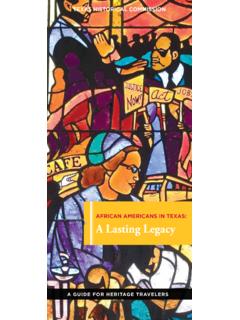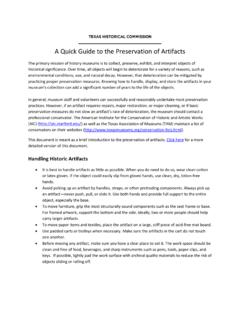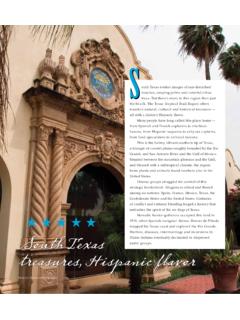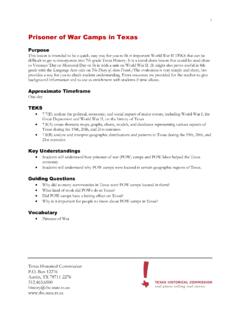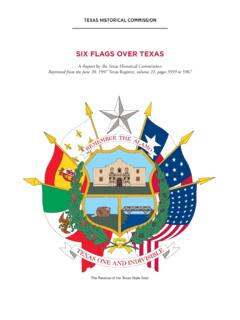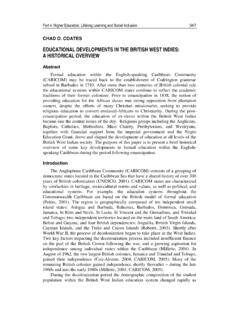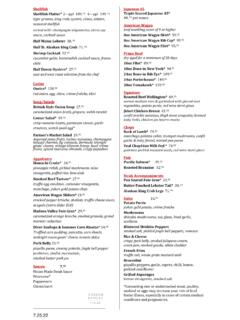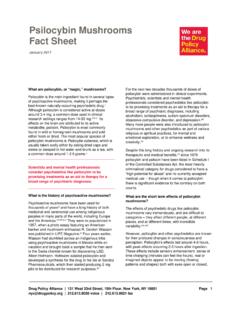Transcription of The Texas Historical Commission, IN THE CIVIL WAR
1 TEXASIN THE CIVIL WARTEXASIN THE CIVIL WARSTORIES OF SACRIFICE,VALOR, AND HOPEThe Texas Historical Commission, the state agency for historic preservation, administers a variety of programs to preserve the archeological, Historical and cultural resources of Texas . Texas Heritage Trails Program The Texas Historical Commission is a leader in implementing and promoting heritage tourism efforts in Texas . The Texas Heritage Trails Program is the agency s top tourism s like a whole other Historical COMMISSIONOur MissionTo protect and preserve the state s historic and prehistoric resources for the use, education, enjoyment, and economic benefit of present and future 2013, Texas Historical CommissionTexas in theCivil WarMarch 2, 1861 The United States was rife with conflict and controversy in the years leading to the CIVIL War.
2 Perhaps nowhere was the struggle more complex than in Texas . Some Texans supported the Union, but were concerned about political attacks on Southern institutions. Texas had been part of the United States just 15 years when secessionists prevailed in a statewide election. Texas formally seceded on March 2, 1861 to become the seventh state in the new Confederacy. Gov. Sam Houston was against secession, and struggled with loyalties to both his nation and his adopted state. His firm belief in the Union cost him his office when he refused to take an oath of allegiance to the new government.
3 Gov. Sam Houston refused to declare loyaltyto the Confederacy and was removed from office by the Texas secession convention in March HOUSTON PORTRAITTT ensions were high when the CIVIL War began, and Texans responded in impressive numbers. By the end of 1861, more than 25,000 had joined the Confederate army. During the course of the war, nearly 90,000 Texans served in the military. The National Park Service estimates that by war's end more than 20,000 Hispanics fought in the CIVIL War nationwide: some for the Union and some for the Confederacy. Thousands more civilians lent hearts and hands on the home front.
4 They distinguished themselves in every major campaign of the war from New Mexico to Pennsylvania. Texas forces figured prominently at celebrated battle sites such as Gettysburg, Antietam, Second Manassas, Wilson's Creek, The Wilderness, Vicksburg, Corinth, Shiloh, Chickamauga, Glorieta Pass, Pea Ridge, Gaine's Mill, Franklin, and Mansfield. Leaders of the Texas forces included legendary figures John Bell Hood, Albert Sidney Johnston, John Bankhead Magruder, Patrick Cleburne, and Ben Texas , Confederate and state forces repulsed Union invaders at Brownsville, Sabine Pass, Galveston, Corpus Christi, and Laredo, and sustained naval bombardments in several coastal areas.
5 They fought frontier and border raiders, evaded federal blockades, protected internal trade routes and operated prisoner of war CIVIL War came to an end in Texas . Soldiers fought the last land battle at Palmito Ranch near Brownsville more than a month after Gen. Robert E. Lee surrendered to Gen. Ulysses S. Grant at Appomattox Court House in Virginia. The surrender of the Trans-Mississippi Department of the Confederacy at Galveston on June 2, 1865 was, as Capt. Benjamin Franklin Sands of the United States Navy noted, the closing act of the Great Rebellion. Just a few weeks later on June 19, Gen.
6 gordon Granger, commander of troops in Texas , arrived in Galveston and ended slavery in Texas by issuing an order that the Emancipation Proclamation was in effect in Texas later to become known as February 16, 1861, Gen. David Twiggs surrendered all United States military posts in Texas , including his San Antonio headquarters to the Texas Committee of Public CIVIL War was a major turning point in American history. Our growing nation was deeply divided, and the resulting battles are legendary. The end of slavery and the beginning of Reconstruction marked a new era for the played an important role in the war, and many historic sites, museums, monuments and cemeteries tell the stories.
7 The Texas Historical Commission (THC) created this brochure to encourage travelers to explore sites related to Texas CIVIL War history. The CIVIL War was a major turning point in American history. Gen. Albert Sidney Johnstonof Texas was considered oneof the South's most promisingofficers at the time of his deathin 1862 on the battlefieldat Shiloh, am making a Southern Confederacy Flag. It has a blue centre with 7 stars of white in a circle and two red and one white stripes. Tomorrow the Legislature of Texas convenes, and it is to be raised tomorrow, as soon as we can get it done.
8 The Lone Star Flag has been flying ever since Lincoln s election was confirmed. We will soon need to add more E. A. COLEMAN , 1861In an 1861 letter to her sister, Coleman of Texas described the Confederate First National flag, shown will soon need to add more E. A. COLEMAN , 1861In an 1861 letter to her sister, Coleman of Texas described the Confederate First National flag, shown me tell you what is may alter the sacrifice of countless millions of treasures and hundredsof thousands of precious lines, win Southern Independence, but I doubt it. The North is determined to preservethis Union.
9 They are not a fieryimpulsive people as you are, for theylive in colder climates. But when they begin to move in a given direction,they move with the steady momentumand perseverance of a mighty avalanche. From an 1861 speechby Gov. Sam Houstonat Galveston, a few days prior to passage of the Ordinance of First Regiment patrolled the frontier along a line of forts from the Red River to the Rio REGIMENTThe organization deterred, but could not prevent, Indian attacks. A particularly vicious raid by Kiowas and Comanches in 1864 left a dozen Texans dead and seven captured. The raid occurred along Elm Creek in Young County during the fall of 1864.
10 Despite the Indian threat, frontier troops spent more time enforcing Confederate conscription laws, arresting deserters, controlling Unionist activity, and chasing renegades and outlaws. After the removal of United States troops from Texas military installations, the state and the Confederacy assumed responsibility for the protection of the frontier. The First Regiment, Texas Mounted Riflemen, were mustered into Confederate service early in 1861 to patrol the frontier along a line of forts from the Red River to the Rio Grande. Though the unit was effective in controlling Indian raids in the region, their enlistment expired in April Frontier Regiment filled the void left by the First Regiment by establishing 16 camps just west of the line of settlements.
